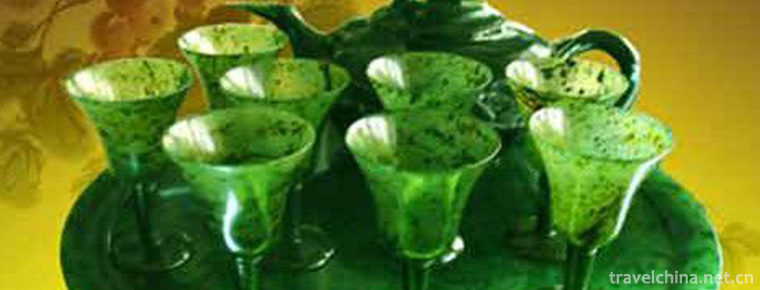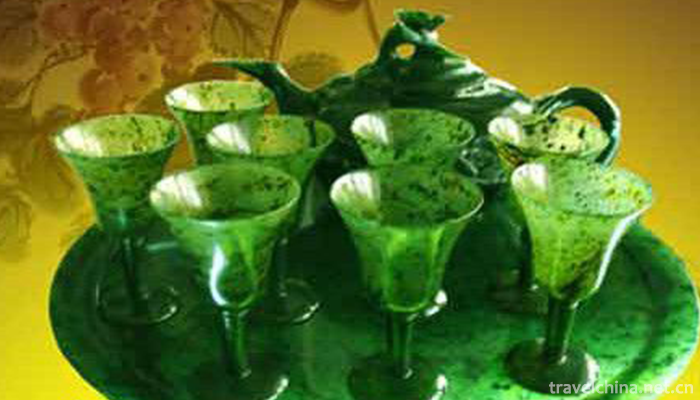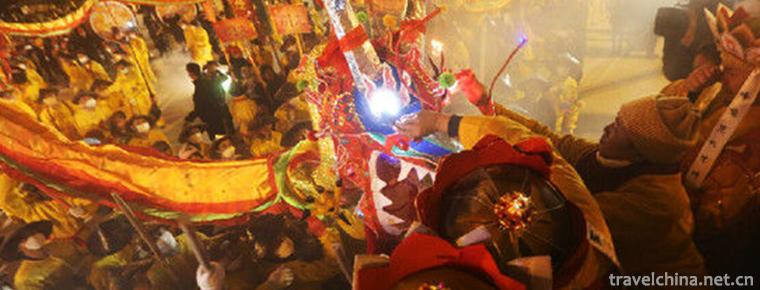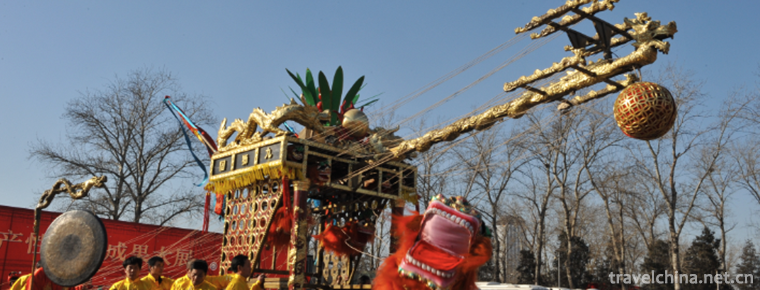2019-02-25

- By ChinaWiki.net
- Chinese Edition
- 2019-07-11
Nightlight Cup Carving
Nightlight Cup Carving, a traditional folk art of Jiuquan City in Gansu Province, is one of the national intangible cultural heritage.
The manufacture of luminous cup needs 28 complicated processes. First of all, we need to select the material, then make the blank according to a certain size to form the preliminary noctilucent cup. Finally, after 14 processes, such as fine grinding, flushing, milling, rubbing, polishing and wax scalding, we use horsetail net to polish the noctilucent cup, that is, to make the noctilucent cup.
On May 20, 2006, the noctilucent cup carving was approved by the State Council of the People's Republic of China and listed in the first batch of national intangible cultural heritage list, the heritage number is_-31.
Historical Origin
Night light cup carving has a long history. According to Shizhou Ji, when King Zhou Mu was king, the Western Regions offered tribute to the court, including the statement that "night light often filled cups".
Tang Dynasty poet Wang Han traveled to the Western Regions to write the poem Liangzhou Opera, which said: grape wine night cup, want to drink Pipa promptly. Don't laugh when you are drunk in the sand. How many people have fought in the past? Among them, the charm of this folk handicraft is described.
The late Ming and early Qing Dynasties were the flourishing period of the production of night-light cups. There were more than ten jade workshops in Jiuquan to make night-light cups.
For various reasons, there were only three production workshops left in Jiuquan until the Republic of China.
In the early days of the founding of New China, jade workers embarked on the road of public-private partnership.
In 1957, old artist Wang Sanzhong attended the National Congress of Old Artists of Arts and Crafts in Beijing, and presented two night glasses to Chairman Mao on behalf of the people of Jiuquan.
In the summer of 1958, when Comrade Zhu De visited Jiuquan in Northwest China, he saw the Night Light Cup and said, "The Night Light Cup, a traditional handicraft, can't be cut off and should be developed vigorously." At the end of the same year, a local state-owned Jiuquan Nightlight Cup Factory was established.
During the Cultural Revolution, production was cold and quiet, and was in a depression.
After the reform and opening-up, in order to promote national culture, Jiuquan Municipal Government vigorously promoted Jiuquan Night Glow Cup and its production technology as Jiuquan City's tourism image products, which have been revitalized and developed. The products have won 18 awards in the national tourism commodity research and evaluation.
Cultural characteristics
Characteristic
"Jiuquan Night Light Cup" is unique in shape and exquisite in style. Its color is black, black, black, black and green, like mutton grease, and it is used to pour wine. It tastes sweet and sweet, and remains unchanged for a long time. Especially when drinking in the moonlight, the glass is bright as water, which seems to have a strange luster. Therefore, since ancient times, there has been a good tale of "Wine Pan Night Light Cup". Noctilucent cup carving has been specially crafted to withstand high temperature, severe cold, no discoloration of liquor, and alcohol.
Texture of material
Jiuquan Night Light Cup is made of fine Qilian Mountain Jade, with natural decoration, thin as paper, bright as mirror, smooth inside and outside, transparent and bright jade color.
classification
Noctilucent cup is divided into two categories: traditional noctilucent cup and antique noctilucent cup.
Traditional night light cups have large, medium and small goblets, flat bottom cups, beer cups, Mini cups, and three Baotai jades covered bowls.
There are more than eighty kinds of antique cups, such as Jue cup, Phoenix cup, jaundice cup, origin cup, double phoenix cup, double dragon crabapple cup and wine utensils, tea sets, jade carving craft pendants, etc.
Production Procedure
Production process
The first process is to select the best material. It has long been recognized by craftsmen that the material of the old hill nest in Qilian Mountains is the best. Craftsmen cut the material into different shapes according to the sizes of wine cups. First, they cut it into cylinders. Then they cut it into blanks according to certain sizes. The production of blanks requires five processes. In this way, the blank is cut and the shape is polished, and the preliminary model of the luminous cup is formed. The production of the preliminary model needs four working procedures, then the cutting, and then the cutting, all of which need five working procedures. After the completion of this process, the noctilucent cup is basically formed, and then through 14 processes such as complex and meticulous grinding, flushing, milling, rubbing, polishing, wax scalding, etc., the last one is polished with horsetail net, in order to finally make a crystal clear noctilucent cup. Night glow cup production requirements are very strict, the cup is as thin as paper, tall, thin, thick, color must be the same, the surface must be smooth and delicate.
Drilling rod material fixed length blanking bit drilling two drills fixed bottom tie cup punching cup grinding cup head two balls three balls cleaning bottom pulling side chute rough grinding fine grinding polishing scalding wax.
technological requirements
1. Length fixing: The bar is cut into a jade blank according to the size of the product, and the size of the jade blank is required to be greater than or equal to the size of the product 5 mm.
2. Drilling (bit drilling, second drilling and bottom setting): According to the specifications of utensils, the jade billet is drilled and second drilled with drill barrel, and the bottom of the jade billet is drilled and finalized.
3. Cup-binding: According to the cup-shaped diamond powder slices to remove the excess part, eight pieces are required to be removed, the shape is symmetrical, and the shape is octagonal pyramid.
4. Cup punching: The cup body is shaped by grinding wheel, which requires the cup body to be flat, symmetrical and without edges and corners.
5. Grinding cup: According to the specifications of utensils, grinding cup with grinding wheels to form a smooth surface, without edges and corners. (Applicable only to the manufacturing process of high-seat cups)
6. Cutting: Cutting the head, two, three, clear the bottom, pull the side. The inside and outside of the cup should be flat, without edges and corners, and the cup wall should be thin and even, and the thickness should not be less than 2 mm.
7. Rubbing cup: Flatten the cup mouth and bottom, requiring the cup mouth and bottom to be flat, and the cup mouth is 90 degrees perpendicular to the cup body.
8. Fine grinding: The inside and outside of the noctilucent cup are polished smoothly with fine mortar, which requires the inside and outside of the noctilucent cup to be smooth and smooth.
9. Polishing: The noctilucent cup is polished smoothly with polishing material. The inside and outside of the cup are required to be bright and lubricated. The cup body is transparent or translucent, without any trace of processing.
Subject works
Among the various noctilucent cups, the representative ones are the noctilucent cup carved octagonal dragon pot and the noctilucent cup imitating the ancient Phoenix cup.
The noctilucent cup carved octagonal dragon pot is carved from large pieces of ink and jade. Its production is exquisite and its craft is very fine. Dragon pot lid is carved by hollowing technology. There are also faucet shapes on the lid, and delicate carvings on the spout and handle. The bottom of the pot is semi-circular. The shape of the pot is very unique. The whole pot body is polygonal. Noctilucent cup carved octagonal dragon pot has vivid shape, natural color, crystal clear, peculiar and beautiful texture, rich in ancient charm.
Noctilucent cup imitates the ancient wind cup, which is a drinking utensil made according to the deformed shape of birds and animals in Shang Dynasty and early two weeks. Noctilucent cup imitates the ancient Phoenix cup by making use of the characteristics of the original shape. In the process of design and manufacture, the Phoenix cup is refined and refined. The Phoenix cup is based on the phoenix, the king of birds. The upper part of the decoration is engraved with banana leaf steamed grain, while the mouth, waist and tail are engraved with grain. The modified Phoenix cup is an ancient and elegant drinking wine. Besides, there are also imitation ancient dragon cups, which are also well carved and complement each other with Phoenix cups.
Inheritance and Protection
Inheritance value
Jiuquan Night Light Cup is a valuable source of historical materials for studying ancient Western culture, folk handicraft, folk customs and so on. Protecting Jiuquan Night Light Cup Carving can enrich the culture and art of the motherland, and make the traditional folk crafts spread to the contemporary two dry years carry forward: it can promote the prosperity of the jade industry and promote the development of Jiuquan tourism industry.
Current situation of inheritance
Since the 1980s, Jiuquan Night Light Cup has been made all over Jiuquan. Because of overexploitation of jade and ignorance of the technology of jade mining, the rate of finished products of jade mining is low, resulting in waste and scarcity of jade resources.
Heritage figures
Huang Yuesu, male, Han, born in 1950 in Zhuji, Zhejiang Province. The first batch of national intangible cultural heritage projects, the representative inheritors of luminous cup sculpture, the representative works are: "Antique luminous cup" and "Golden Foot Cup".
protective measures
Jiuquan Night Light Cup Factory supported by Jiuquan Municipal Government registered the brand trademark of Jiuquan Night Light Cup on July 5, 1983, and applied for regional protection of the origin of local products in June 2005. The Jiuquan Noctilucent Cup is determined to be a green environmental protection product through the analysis of sampling and testing conducted by the quality supervision and geological technology departments. Measures such as collecting and duplicating obsolete equipment and tools are taken to reproduce their technological characteristics.
social influence
Important Exhibitions
On April 11, 2012, the Nightlight Cup Carving was displayed in the "National Consumption Promotion Month of 2012 - Imagination Brand Exhibition" sponsored by the Ministry of Commerce.
In May 11, 2017, a series of reports on the voice of the countryside in China, the first piece of "the scenery along the road", was called "the wine cup of grape wine".
Relevant Legends
For a long time, Jiuquan folklore has spread such an interesting story: in the Western Han Dynasty, Huo Qubing, a young and promising general on horseback, was ordered by Emperor Wudi of Han Dynasty to lead his troops to attack the Xiongnu who invaded the frontier and plundered people in the Northwest frontier. Later, the general defeated the Huns and returned triumphantly. He was stationed by the beautiful spring to celebrate the victory. When the emperor heard the news of victory, he gave the emperor an altar of wine and sent people from thousands of miles to reward the general. General Huo Qubing thought that the victory of the battle was due to the merits of the generals and soldiers in the whole army. The imperial army could not drink wine alone, but there were fewer people and less distribution. He poured wine into the spring and shared it with all the generals and soldiers. Since then, the name of Jiuquan has been circulating for thousands of years, so it is called Jiuquan. Thereafter, it was named after the spring. Jiuquan County Zhilufu County Town is Jiuquan City today. In Jin Dynasty, it was changed to Fulu County and was once the capital city of Xiliang Li. At the end of Sui Dynasty, Jiuquan County was changed into Jiuquan County.
(2) Legend has it that the spring water under the ancient Jiuquan City has a strong aroma of wine, which is especially strong at dusk and can be smelled five miles away. One day, the fragrance of wine was smelled by two immortals who came out from the sky to inspect, namely, Nandou Xingjun and Beidou Xingjun. These two old men were famous wine Fairies in the sky. When they heard the strong aroma of wine, they would not give up naturally. So they lowered their clouds and fell on the Great Willow Emperor beside the spring. Beidou Xingjun squatted beside the spring and said, "What a wine spring!" Nandou Xingjun picked up a stone and blew his breath into two glasses. While they were drinking happily by the spring, they played chess on the slate. It was getting dark, and there happened to be no moonlight. But strangely, the chessboard is still clearly visible. Watch out, it's the light from the glass. Since then, the place has been named "Jiuquan", which imitates the wine cups left by two immortals and is called "Nightlight Cup".

Ask a Question
Your email address will not be published.



0 Questions